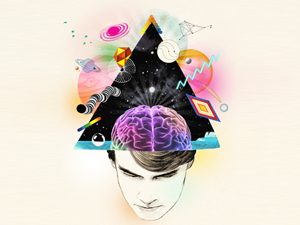The Beautiful Life of Your Brain
Updated: Apr. 16, 2016
A look at the neuroscience of our most human traits—love, anger, compassion—and how to harness your mental muscle for a more fulfilling life

At this very moment, the twin Voyager spacecrafts, launched in 1977, are carrying precious cargo on their journey beyond the solar system: special records that contain, among other things, a Mozart aria, greetings in 55 languages, and the brain waves of a young woman newly in love.
Renowned astronomer Carl Sagan led the Golden Record project, intended to introduce the people of Earth to any beings the spacecrafts might encounter. To include as part of the contents, Sagan’s teammate Ann Druyan had her brain waves measured with an EEG test, which was then compressed into one minute of sound.
Just two days before, Sagan and Druyan had realized they were in love—an overwhelming sensation flooding Druyan’s mind during the EEG. So today, 18 years after Druyan became Sagan’s widow, that precious song of a brain in love (it sounds like exploding firecrackers) is still soaring into the vastness of space.
To distill the essence of the human race for an interstellar audience, Sagan and his team chose to reveal a hint of our brain’s inner workings. The question of what makes us human is well-worn territory for philosophers, theologians, and artists. But to many scientists, the answer lies in the mystery of our brain, the three-pound organ between our ears firing nearly 100 billion neurons.
“On a physical level, there’s just a bunch of atoms sloshing around,” says Christof Koch, PhD, chief scientific officer of the Allen Institute for Brain Science in Seattle. “But then there is a magical jump where this activity turns into feelings of anger or the memory of your first kiss.”
Advances in technology, such as fMRI scanning, allow us to see how regions of the brain function and where certain emotions originate. Last year, President Obama declared “the next great American project” to be the Brain Research Through Advancing Innovative Neurotechnologies (BRAIN) Initiative, which pledged scientists financial support to crack our brain’s mental code.
Experts hope such efforts will advance the fight against autism, Alzheimer’s, and depression. This research may also shed light on questions about how we fall in love or make a tough decision, says Thomas R. Insel, MD, director of the National Institute of Mental Health. “To understand the brain is the ultimate journey to find out who we are,” he says.
A Brief History of Your Marvelous Mind
This sophisticated organ has been evolving for millions of years through a process similar to adding ice cream scoops to a cone, says David J. Linden, PhD, a Johns Hopkins University neuroscientist and author of The Compass of Pleasure. “Lower parts like the cerebellum and hypothalamus, which handle survival-oriented behavior like sex drive and eating, haven’t evolved as much, so what a lizard has and what we have are not fundamentally different,” he says, describing the first evolutionary scoop.
“Higher centers involved in emotional processing, like the hippocampus and amygdala, are a lot more elaborate in mice than in lizards,” he says of the second scoop. “Then as you move farther up, humans have a giant, complex cortex,” he says of the top scoop. This is home to our thoughts and language. The interaction between these older and newer brain regions makes us who we are today.
Here’s another way to look at the haphazard way our brains have evolved. “Say someone asked you to build a racing boat, but they gave you a wooden rowboat and said you could only add things to make it into the racing boat,” says Linden. “That’s what brain evolution has been: You can only subtly tweak what was there before and can’t change the basic plan.” The interaction between these older and newer brain regions makes us who we are today.
“Both people and mice can feel pleasure from eating and making babies, which both need to survive and pass down their genes. But only a human can take pleasure in fasting or abstaining from sex, which has no evolutionary advantage. The miracle of human thinking is that our ancient pleasure circuitry can be activated by higher, more complicated parts of our brain,” Linden explains.
“In a way, this is the basis of all human culture,” he continues. “That we can take pleasure from things that are utterly arbitrary is what enriches so much of our lives.”
Human evolution is a glacial process, but we can directly affect our personal “evolution” in our lifetime. “There’s a well-known saying: Neurons that fire together, wire together,” says neuropsychologist Rick Hanson, PhD, author of Hardwiring Happiness: The New Brain Science of Contentment, Calm, and Confidence. Repeated patterns of thoughts and feelings actually change our brain structure—evidenced by practices such as mindfulness meditation.
In other words, we can help build our own racing boat. Here’s how our brain operates during seven common situations. We can use these insights to flex our mental muscle.
Your Brain Under Criticism
Think back to your last performance review. “Your boss starts by saying 19 positive things,” says Hanson. “But if there’s one piece of criticism at the end, that’s what you remember. What sticks is the negative 20th.”
That overreaction—called negativity bias in psychology circles—helped keep ancient humans alive.
“Ancestors had to ‘get carrots,’ meaning food and mates, and ‘avoid sticks,’ such as predators,” Hanson explains. “If you don’t get a carrot today, you’ll have another chance tomorrow. But if you fail to avoid a predator? Whap! Game over. Our brains became wired to hyper-focus on bad news.” He continues, “The brain is like Velcro for bad experiences but Teflon for good ones.”
Simple practices can help you counteract this bias. “Negativity quickly becomes neural structure,” he says. “Positive experiences, however, can take more time to encode. Intentionally feeling positive experiences longer helps them sink in, which can help you become happier and more resilient.” Savor receiving a compliment. Be mindful during happy moments; note details so they’re easier to remember.
Your Brain While Procrastinating
When you put off a pressing project, you avoid negative emotions caused by an unpleasant task because you want to feel good now. But all you’re really doing is giving the problem to your future self. “So the question neurologically becomes, Why do we treat Future Self like that?” says Timothy A. Pychyl, PhD, an associate professor of psychology at Carleton University in Ottawa, Canada, and the author of Solving the Procrastination Puzzle.
One study that used fMRI to see what parts of the brain were active when subjects thought about their present selves, their future selves, and a stranger found that the brain thinks about the future self more similarly to the way it thinks about a stranger.
Procrastination is also the struggle between two different brain systems. The limbic system, which is responsible for our basic emotions, is an old part of our brain (in the second ice cream scoop). It’s also a very fast automated system that responds nonconsciously. It wants immediate mood repair—to feel good now. Then there’s the newer prefrontal cortex (the third scoop), home of executive function, which involves planning and impulse control. It’s a slower process you have to consciously kick into gear.
When you contemplate doing your taxes, the limbic system first activates with its urgent goal of feeling better now, which is accomplished by avoiding this dreaded task. Lagging behind is the more responsible prefrontal cortex, which you need to engage to think about the benefits of completing your tax return on time.

Your Brain in Love
The luckiest among us relate to not only the romantic love Ann Druyan experienced when she first fell for Carl Sagan but also the long-lasting bond that linked the couple until Sagan’s death 19 years later. Those two distinct types of love arise from different brain regions, says Helen Fisher, PhD, a member of the Center for Human Evolutionary Studies at Rutgers University.
“Romantic love originates in the ventral tegmental area in the oldest part of the brain near centers that govern thirst and hunger,” she explains. “Romantic love is a basic drive that focuses our energy on winning life’s greatest prize: a mating partner. It is a mechanism for survival.”
A primary brain region linked with attachment, however, is the ventral pallidum, which is more modern and higher up (in the third scoop). “Intense, romantic attraction is a more primitive response than feelings of attachment, which are more recent,” she says. This circuitry is linked to lifelong love.
“People in love long term show activity in the ventral medial prefrontal cortex, which is linked with ‘positive illusion’—the ability to overlook cons and focus on pros,” Fisher says. People in long-lasting love relationships say things like “It annoys me when he doesn’t pick up his socks, but I love his sense of humor.” This mind-set may help nurture loving feelings long after the honeymoon period.
Your Brain on Road Rage
Being pepper-sprayed, getting punched, and landing in jail are all outcomes of recent cases of … traffic incidents like tailgating. How is it that road rage can result in 12,610 injuries and even 218 murders over a seven-year period, as a AAA report concluded?
Blame a psychological quirk called fundamental attribution error. “We assume that someone’s behavior is due to their innate disposition, as opposed to thinking about the situation that could be causing it,” says Joseph Moran, PhD, research associate at the Harvard University Center for Brain Science. When somebody cuts you off, you assume that person is a jerk—instead of wondering if he’s rushing to the hospital—and that makes you mad.
Our brains were built to overreact to a perceived threat. “The same neuronal machinery that protected our ancestors from charging lions is locked and loaded when we encounter ordinary stresses like traffic,” says neuropsychologist Rick Hanson. Your body releases the hormone cortisol; this sets off the brain’s alarm bell by stimulating the emotionally charged amygdala while damaging neurons in the hippocampus, which shrinks the calming part of the brain that puts things in perspective.
To bring this stress response under control, we can use our newer brain regions, like the prefrontal cortex, to regulate our older ones. For example: Everyone has an involuntary reaction to a stressful situation like giving a public talk. “We feel butterflies and have a dry mouth because that’s how evolution has trained us,” Moran explains. But some people can recast that nervous energy as a positive force. Their higher brain regions allow them to reinterpret physical symptoms as a sign they are excited and ready to connect with the crowd.
When you feel angry behind the wheel, forcing yourself to refocus—say, by thinking, I’ll be only 15 minutes late, or, I might as well enjoy the nice day while I wait—may help you dial down your emotional reaction.
Your Brain While Dreaming
A participant came to a dream study with a dilemma. He couldn’t decide between two graduate programs near his Massachusetts home and two farther west. Then he dreamed he was in a plane flying over a map. The pilot said they were having engine trouble and needed a safe place to land. The student suggested Massachusetts, but the pilot said Massachusetts was “very dangerous.” The student woke up realizing the right choice was a program away from home.
By conducting such dream studies, Deirdre Barrett, PhD, assistant clinical professor of psychology at Harvard University, has been exploring the complex workings of the brain’s sleep circuitry. After you conk out, she explains, your brain becomes quiet, but after 90 minutes, it dramatically reactivates with rapid eye movement (REM) sleep, becoming as active as it is when you’re awake. However, that activity comes from a different distribution of brain regions.
While the primary visual cortex, which receives light input from your eyes, is less active while you’re sleeping than when you’re awake, the secondary visual cortex, which is involved when you imagine something, is most active during REM sleep. The motor cortex turns on, firing off movement commands that are countered by another area that paralyzes muscles during sleep. Also notably, the “censoring” prefrontal cortex, which helps ensure you behave in conventional ways, becomes less active while you snooze.
Not only does this new distribution of activity match the iconic features of dreams—visually rich environments where you perform over-the-top actions and events take bizarre twists—but it also makes dreams fertile ground for solving the problems of your waking life. Increased activity in the secondary visual cortex allows your dreaming mind to visualize new solutions to problems. “Inventors might see a design, or chemists might visualize the structure of molecules,” says Barrett. Decreased activity in the prefrontal cortex can help in instances where you’ve been stuck.
To maximize dreaming’s problem-solving benefits, Barrett suggests in her book The Committee of Sleep that at bedtime, you phrase your concern in a succinct way by writing it or repeating it to yourself. Then come up with a visual image representing the issue, and tell yourself you want to dream an answer. Of equal importance, keep a pad and pen by the bed, and write down your dream as soon as you wake up. “Dreams are held in short-term memory, but writing them down transfers them to long-term memory,” says Barrett.
Your Brain While Listening to Music
Imagine you’re in line for coffee, and Pharrell Williams’s bouncing hit “Happy” comes on the radio. The resulting cascade of mental activity it takes to process the music “touches on all the most advanced aspects of human cognition,” says Robert Zatorre, PhD, professor of neuroscience at the Montreal Neurological Institute and Hospital at McGill University.
First, the sound hits your ear, activating a series of structures from the cochlea (where vibrations are turned into electrical impulses) to the brain’s cortex. When you recognize the tune—its name or where you last heard it—your auditory cortex is connecting with regions that handle memory retrieval.
Then, if you start tapping your foot, you’ve activated the motor cortex in a very particular way because you’re tapping to the exact beat of the song.
Finally, if “Happy” has you feeling, well, happy, the song has turned on your brain’s reward system—ancient, powerful circuitry triggered by essentials for survival like eating and sex.
Why does something seemingly nonessential like music engage that life-promoting system? Scientists are still trying to figure that out, but what happens to your brain when you hear a song you love may provide some crucial insight.
“Music increases cross talk between brain structures in old reward centers that handle pleasure and newer areas of the cortex that handle prediction and anticipation,” says Zatorre. In one study, he found that the brain released dopamine, a chemical linked to pleasure and reward, in anticipation of a subject’s favorite part of the song. So it may be that music fuels your brain’s innate desire to detect patterns and solve problems.

Your Brain While Meditating
Meditation may be a powerful way to build our brain’s old rowboat into a sleek racer. The practice can grow brain tissue, improving our moods and making us more resilient.
“Meditation involves metacognition—thinking about thinking, paying attention to attention—which uses the prefrontal cortex,” says Hanson. “It engages the entire brain, accessing sensory and emotional experiences, wants and drives, and deep ancient substrates of consciousness. Meditation seems to engage the most modern parts of the brain as well as the most ancient ones.”
In one study, participants who meditated 40 minutes every day showed thicker gray matter in areas involved in attention, decision making, and working memory, compared with those who didn’t meditate. Another study showed that eight weeks of mindfulness meditation boosted gray matter density in several regions, including the hippocampus (involved in learning and memory), and decreased gray matter density in the amygdala (which plays a role in stress).
“Sitting down, focusing on breathing, and relaxing every day is actually going to build brain structure?” Hanson says. “That’s pretty cool!”